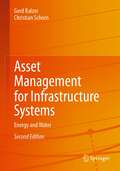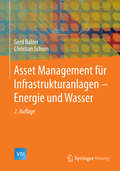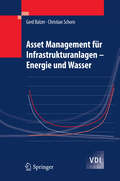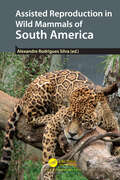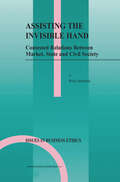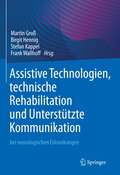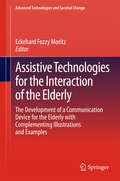- Table View
- List View
Asset Management Excellence: Optimizing Equipment Life-Cycle Decisions, Second Edition
by John D. Campbell Andrew K. S. Jardine Joel McGlynnDuring the eight years since the publication of Maintenance Excellence: Optimizing Equipment Life-Cycle Decisions the business environment has changed drastically. Globalization, consolidation, and changes in technology challenge asset management and maintenance professionals to be more efficient. Globalization and consolidation have been particula
Asset Management Excellence: Optimizing Equipment Life-Cycle Decisions (Mechanical Engineering)
by John D. Campbell Andrew K. S. Jardine Joel McGlynn Don M. BarryThis is the third edition of Asset Management Excellence: Optimizing Equipment Life-Cycle Decisions. This edition acknowledges and introduces the many changes to the Asset Management business while continuing to explain the supporting fundamentals. Since the second edition, there have been many influences of change in asset management, society’s expectations, and supporting technologies. In this edition, the contributors have revisited the content and have updated and added insights and information based on the emerging influences in thinking and the continued evolution of applied technologies since the prior editions. New in the Third Edition: Updates across each of the second edition chapters to align with today’s insights Updates on technologies now available to support Asset Management, including related software packaging, the Internet of Things (IoT), Machine Learning, and Artificial Intelligence Insights on how Information Technology can step up to help an asset-intensive organization compete, drive to operational excellence and automation A chapter on sustainability and the influence Asset Management may have on this higher-focus priority A chapter on change enablement as the process and technology changes impact the various stakeholders of asset-intensive organizations The fundamentals of Asset Management are essential as Asset-intensive organizations look to technologies to help them compete. AI is becoming pervasive but must be confirmed and aligned with the fundamentals. This edition will provoke thought as each organization determines its next steps toward its new challenges in Asset Management.
Asset Management for Infrastructure Systems: Energy and Water
by Gerd Balzer Christian SchornThis book offers a broad overview of asset management processes for different utilities, with a special emphasis on energy and water. It provides readers with important practical considerations concerning the development of new competitive structures and procedures for guaranteeing a sufficient supply of energy and water in a regulated environment, using clearly defined technical and economic cornerstones. On the one hand, asset owners expect suitable interests from their investment and business growth; on the other hand, regulators focus more on a reliable and cost-effective customer supply. This book shows how to take into consideration these different perspectives in the process of designing new structures, and how to guarantee organizational transparency. It describes essential principles and boundary conditions for ensuring the optimal use of resources in a network, covering issues relating to equipment service life, IT landscape and computer programs, operational costs management, and investment and maintenance strategies, highlighting their impact on the organization of the company. This thoroughly revised and updated second edition, includes extensive information about IEC standard (IEC/TS 63060), and cover operation research methods focusing on the optimization of the maintenance tasks. Furthermore, a discussion on the political environment has been included, with a special emphasis on the European situation and the “Green Deal”: specifically, some measures to cope with the topic of energy transition are presented. Last, but not least, a brand-new chapter on condition assessment has been included.
Asset Management für Infrastrukturanlagen - Energie und Wasser (VDI-Buch)
by Gerd Balzer Christian SchornDie Aufgabe eines Versorgungsunternehmens (Elektrizität, Gas, Wasser) ist es, eine ausreichende Versorgung unter technischen und finanziellen Randbedingungen zu ermöglichen. Aufgrund der Veränderungen dieser Randbedingungen seit der ersten Auflage war es notwendig, einige Abschnitte zu überarbeiten bzw. neu hinzuzufügen. Hierzu gehört die Ergänzung der neuen Instandhaltungsnorm (DIN V VDE 0109), die von der Deutschen Elektrotechnischen Kommission (DKE) herausgegeben wurde, als auch Überlegungen, wie mit Hilfe von speziellen Verfahren aus dem Bereich des Operation Research eine Optimierung der Instandhaltungsaufgaben möglich ist. Darüber hinaus erfordert die Dezentralisierung in der elektrotechnischen Energieversorgung neue Planungsprämissen, die im Abschnitt „Netzplanung in Smart Grid“ dargestellt sind. Diese haben auch Auswirkungen auf die Asset Strategien. Es zeigt sich, dass das Arbeitsgebiet „Asset Management“ aufgrund der sich ändernden Rahmenbedingungen noch nicht abgeschlossen ist.
Asset Management für Infrastrukturanlagen - Energie und Wasser (VDI-Buch)
by Gerd Balzer Christian SchornDie Aufgabe eines Versorgungsunternehmens besteht darin, seine Kunden zuverlässig mit Elektrizität, Gas oder Wasser zu versorgen. Um diese Aufgabe in einem regulierten Markt zu erfüllen, können Versorgungsunternehmen neue Strukturen und Verfahren entwickeln. Damit sie dabei sowohl den Eigentümern als auch der Regulierungsinstanz gerecht werden, ist es sinnvoll, bisherige Prozesse neu zu strukturieren. Die Autoren liefern einen umfassenden Überblick zu Asset-Management-Prozessen, die derzeit in Versorgungsunternehmen umgesetzt werden.
Asset Management of Bridges: Proceedings of the 9th New York Bridge Conference, August 21-22, 2017, New York City, USA
by Khaled M. MahmoudMaintaining bridges in good condition has extended service life and proven to be more cost effective than allowing degradation to advance, necessitating costlier bridge rehabilitation or replacement projects. Preventive maintenance is therefore an important tool to retard deterioration and sustain the safe operation of bridges. This includes a continuous effort of periodic inspections, condition evaluations and prioritizing repairs accordingly. The above measures define the framework for asset management of bridges. On August 21-22, 2017, bridge engineering experts from around the world convened at the 9th New York City Bridge Conference to discuss issues of construction, design, inspection, monitoring, preservation and rehabilitation of bridge structures. This volume documents their contributions to the safe operation of bridge assets.
Asset Management of Bridges: Proceedings of the 9th New York Bridge Conference, August 21-22, 2017, New York City, USA
by Khaled M. MahmoudMaintaining bridges in good condition has extended service life and proven to be more cost effective than allowing degradation to advance, necessitating costlier bridge rehabilitation or replacement projects. Preventive maintenance is therefore an important tool to retard deterioration and sustain the safe operation of bridges. This includes a continuous effort of periodic inspections, condition evaluations and prioritizing repairs accordingly. The above measures define the framework for asset management of bridges. On August 21-22, 2017, bridge engineering experts from around the world convened at the 9th New York City Bridge Conference to discuss issues of construction, design, inspection, monitoring, preservation and rehabilitation of bridge structures. This volume documents their contributions to the safe operation of bridge assets.
Assigning Liability for Superfund Cleanups: An Analysis of Policy Options
by Katherine N. Probst Paul R. PortneyWhile more than 2,700 emergency removals of hazardous materials have taken place under Superfund, implementing the long-term cleanup program has been the object of considerable controversy. One of the most contentious issues is whether the liability standards in the law should be revised. The authors analyze the pros and cons associated with the current liability approach, as well as with a variety of alternative strategies.
Assigning Liability for Superfund Cleanups: An Analysis of Policy Options
by Katherine N. Probst Paul R. PortneyWhile more than 2,700 emergency removals of hazardous materials have taken place under Superfund, implementing the long-term cleanup program has been the object of considerable controversy. One of the most contentious issues is whether the liability standards in the law should be revised. The authors analyze the pros and cons associated with the current liability approach, as well as with a variety of alternative strategies.
Assisted Circulation 3
by Ali F. AbuRahmaAssisted Circulation 3 is an authoritative review of the progress which has been achieved in the last 5 years since the appearance of Assisted Circulation 2 in 1984. The present book highlights the work of well-known experts on - new indications for assisted circulation, - cardiac assist devices as bridges toward transplantation, - temporary mechanical heart support, - results of long term studies into problems of tissue overgrowth, infection, and physiological regulation of cardiac devices, and - new results on cardiac transplantation and the new immunsuppresive regima. Assisted Circulation 3 is the latest product of an ongoing effort by the editors to keep readers abreast of recent advances in the field on a regular basis.
Assisted Eco-Driving: A Practical Guide to the Design and Testing of an Eco-Driving Assistance System (EDAS) (Transportation Human Factors)
by Craig K. Allison James M. Fleming Xingda Yan Roberto Lot Neville A. StantonThis book discusses an integrative approach combining Human Factors expertise with Automotive Engineering. It develops an in-depth case study of designing a fuel-efficient driving intervention and offers an examination of an innovative study of feed-forward eco-driving advice. Assisted Eco-Driving: A Practical Guide to the Design and Testing of an Eco-Driving Assistance System offers an examination of an innovative study of feed-forward eco-driving advice based on current vehicle and road environment status. It presents lessons, insights and utilises a documented scientific and research-led approach to designing novel speed advisory and fuel use minimisation systems suitable for combustion vehicles, hybrids and electric vehicles The audience consists of system designers and those working with interfaces and interactions, UX, human factors and ergonomics and system engineering. Automotive academics, researchers, and practitioners will also find this book of interest.
Assisted Eco-Driving: A Practical Guide to the Design and Testing of an Eco-Driving Assistance System (EDAS) (Transportation Human Factors)
by Craig K. Allison James M. Fleming Xingda Yan Roberto Lot Neville A. StantonThis book discusses an integrative approach combining Human Factors expertise with Automotive Engineering. It develops an in-depth case study of designing a fuel-efficient driving intervention and offers an examination of an innovative study of feed-forward eco-driving advice. Assisted Eco-Driving: A Practical Guide to the Design and Testing of an Eco-Driving Assistance System offers an examination of an innovative study of feed-forward eco-driving advice based on current vehicle and road environment status. It presents lessons, insights and utilises a documented scientific and research-led approach to designing novel speed advisory and fuel use minimisation systems suitable for combustion vehicles, hybrids and electric vehicles The audience consists of system designers and those working with interfaces and interactions, UX, human factors and ergonomics and system engineering. Automotive academics, researchers, and practitioners will also find this book of interest.
Assisted Reproduction in Wild Mammals of South America
by Alexandre Rodrigues SilvaSouth America has one of the greatest riches in the world in terms of biodiversity. Despite all this richness, recent reports warn of different threats to this biodiversity. As a strategy to reduce the rate of loss of animal species, the development and application of assisted reproduction techniques (ARTs) for their conservation currently stands out. Thus, this book compiles information on recent scientific studies regarding the development of ARTs for the conservation of wild mammalian species in South America, thus serving as an important source of reference for professionals and students interested in wildlife conservation.
Assisted Reproduction in Wild Mammals of South America
South America has one of the greatest riches in the world in terms of biodiversity. Despite all this richness, recent reports warn of different threats to this biodiversity. As a strategy to reduce the rate of loss of animal species, the development and application of assisted reproduction techniques (ARTs) for their conservation currently stands out. Thus, this book compiles information on recent scientific studies regarding the development of ARTs for the conservation of wild mammalian species in South America, thus serving as an important source of reference for professionals and students interested in wildlife conservation.
Assisting the Invisible Hand: Contested Relations Between Market, State and Civil Society (Issues in Business Ethics #18)
by W. DubbinkThis is an investigation into contemporary thinking on controlling the market, especially with regard to the problem of dealing with environmental issues. The book contributes to contemporary insight by arguing that the issue of market control must be addressed in terms of the relations between state, market and civil society. It stresses the normative dimensions of the market control issue. The position adopted by the book is that the market cannot be controlled by the state alone.
Assistive Augmentation (Cognitive Science and Technology)
by Jochen Huber Roy Shilkrot Pattie Maes Suranga NanayakkaraThis book addresses Assistive Augmentation, highlighting the design and development of assistive technologies, user interfaces, and interactions that seamlessly integrate with a user’s mind, body, and behavior, providing an enhanced perception. Our senses are the dominant channel we use to perceive the world around us. Whether they have impairments or not, people often find themselves at the limits of their sensorial capabilities. Some seek assistive or enhancing devices that enable them to carry out specific tasks or even transform them into a “superhuman” with capabilities well beyond the ordinary. The overarching topic of this book revolves around the design and development of technologies and interfaces that provide enhanced physical, sensorial and cognitive capabilities: “Assistive Augmentation”. The Assistive Augmentation community convened at an interdisciplinary workshop at the 2014 International Conference on Human Factors in Computing Systems (CHI) in Toronto, Canada. The community is comprised of researchers and practitioners who work at the junction of human–computer interaction, assistive technology and human augmentation. This edited volume, which represents the first tangible outcome of the workshop, presents stimulating discussions on the challenges of Assistive Augmentation as examined through case studies. These studies focus on two main areas: (1) Augmented Sensors and Feedback Modalities, and (2) Design for Assistive Augmentation.
Assistive Technologien, technische Rehabilitation und Unterstützte Kommunikation: bei neurologischen Erkrankungen
by Martin Groß Birgit Hennig Stefan Kappel Frank WallhoffDas interdisziplinäre Grundlagenwerk informiert aus der Perspektive von Neurologie, Rehabilitation, Ingenieurwesen, Pädagogik und Physiotherapie sowie aus Sicht der Patienten über Möglichkeiten und Grenzen des Einsatzes von Technik, um die Teilhabe neurologisch erkrankter Menschen zu verbessern. Ziel des Buches ist, allen Berufsgruppen, die an der Behandlung schwer und komplex erkrankter neurologischer Patienten beteiligt sind, ein umfassendes Verständnis assistiver und rehabilitativer Technologien zu vermitteln.
Assistive Technologies for People with Diverse Abilities (Autism and Child Psychopathology Series)
by Giulio E. Lancioni Nirbhay N. SinghThe familiar image of the disabled tends to emphasize their limitations and reduced quality of life. However, many people with cognitive, motor, and other difficulties also have the capacity to enhance their social interactions, leisure pursuits and daily activities with the aid of assistive technology. Assistive devices from the simple to the sophisticated, have become essential to intervention programs for this population. And not surprisingly the numbers of devices available are growing steadily.Assistive Technologies for People with Diverse Abilities offers expert analysis of pertinent issues coupled with practical discussion of solutions for effective support. Its comprehensive literature review describes current and emerging devices and presents evidence-based guidelines for matching promising technologies to individuals. Program outcomes are assessed, as are their potential impact on the future of the field. In addition, chapters provide detailed descriptions of the personal and social needs of the widest range of individuals with congenital and acquired conditions, including: Acquired brain damage.Communication impairment.Attention and learning difficulties (with special focus on college students).Visual impairment and blindness.Autism spectrum disorders.Behavioral and occupational disorders.Alzheimer's disease.Severe, profound and multiple impairments.The scope and depth of coverage makes Assistive Technologies for People with Diverse Abilities an invaluable resource for researchers, professionals and graduate students in developmental psychology, rehabilitation medicine, educational technology, occupational therapy, speech pathology and clinical psychology.
Assistive Technologies for the Interaction of the Elderly: The Development of a Communication Device for the Elderly with Complementing Illustrations and Examples (Advanced Technologies and Societal Change)
by Eckehard Fozzy MoritzThis book presents a wealth of insights and new conceptualizations for the development of Assistive Technologies for the Interaction of the Elderly. The book arranges the chapters according to important aspects of maximizing the use value in innovation projects. Every chapter will include an executive summary reporting the main results, a storyline using everyday language, and scientific excursions, wherever useful. The book shows how an innovation project should be structured towards maximum use value and how a project should be structured in order to make a difference. It describes the useful categorization of the large group of the elderly to maximize the focus of the innovation and demonstrates the user involvement into innovation activities. Of course, the assessment of such innovative projects is discussed as well as the “lessons learned”. The book also explores the business opportunities and the financial evaluation of aspects of assistive technology.
Assistive Technology Assessment Handbook (Rehabilitation Science in Practice Series)
by Stefano Federici Marcia SchererAssistive Technology Assessment Handbook, Second Edition, proposes an international ideal model for the assistive technology assessment process, outlining how this model can be applied in practice to re-conceptualize the phases of an assistive technology delivery system according to the biopsychosocial model of disability. The model provides reference guidelines for evidence-based practice, guiding both public and private centers that wish to compare, evaluate, and improve their ability to match a person with the correct technology model. This second edition also offers a contribution to the Global Cooperation on Assistive Technology (GATE) initiative, whose activities are strongly focused on the assistive products service delivery model. Organized into three parts, the handbook: gives readers a toolkit for performing assessments; describes the roles of the assessment team members, among them the new profession of psychotechnologist; and reviews technologies for rehabilitation and independent living, including brain–computer interfaces, exoskeletons, and technologies for music therapy. Edited by Stefano Federici and Marcia J. Scherer, this cross-cultural handbook includes contributions from leading experts across five continents, offering a framework for future practice and research.
Assistive Technology Assessment Handbook (Rehabilitation Science in Practice Series)
by Stefano Federici Marcia SchererAssistive Technology Assessment Handbook, Second Edition, proposes an international ideal model for the assistive technology assessment process, outlining how this model can be applied in practice to re-conceptualize the phases of an assistive technology delivery system according to the biopsychosocial model of disability. The model provides reference guidelines for evidence-based practice, guiding both public and private centers that wish to compare, evaluate, and improve their ability to match a person with the correct technology model. This second edition also offers a contribution to the Global Cooperation on Assistive Technology (GATE) initiative, whose activities are strongly focused on the assistive products service delivery model. Organized into three parts, the handbook: gives readers a toolkit for performing assessments; describes the roles of the assessment team members, among them the new profession of psychotechnologist; and reviews technologies for rehabilitation and independent living, including brain–computer interfaces, exoskeletons, and technologies for music therapy. Edited by Stefano Federici and Marcia J. Scherer, this cross-cultural handbook includes contributions from leading experts across five continents, offering a framework for future practice and research.
Assistive Technology Design for Intelligence Augmentation (Synthesis Lectures on Assistive, Rehabilitative, and Health-Preserving Technologies)
by Stefan CarmienAssistive Technology Design for Intelligence Augmentation presents a series of frameworks, perspectives, and design guidelines drawn from disciplines spanning urban design, artificial intelligence, sociology, and new forms of collaborative work, as well as the author's experience in designing systems for people with cognitive disabilities. Many of the topics explored came from the author's graduate studies at the Center for LifeLong Learning and Design, part of the Department of Computer Science and the Institute of Cognitive Science at the University of Colorado, Boulder. The members of the Center for LifeLong Learning and Design came from a wide range of design perspectives including computer science, molecular biology, journalism, architecture, assistive technology (AT), urban design, sociology, and psychology. The main emphasis of this book is to provide leverage for understanding the problems that the AT designer faces rather than facilitating the design process itself. Looking at the designer's task with these lenses often changes the nature of the problem to be solved. The main body of this book consists of a series of short chapters describing a particular approach, its applicability and relevance to design for intelligence augmentation in complex computationally supported systems, and examples in research and the marketplace. The final part of the book consists of listing source documents for each of the topics and a reading list for further exploration. This book provides an introduction to perspectives and frameworks that are not commonly taught in presentations of AT design which may also provide valuable design insights to general human-computer interaction and computer-supported cooperative work researchers and practitioners.
Assistive Technology for Blindness and Low Vision (Rehabilitation Science in Practice Series)
by Roberto Manduchi Sri KurniawanAssistive technology has made it feasible for individuals with a wide range of impairments to engage in many activities, such as education and employment, in ways not previously possible. The key factor is to create consumer-driven technologies that solve the problems by addressing the needs of persons with visual impairments. Assistive Technology for Blindness and Low Vision explores a broad range of technologies that are improving the lives of these individuals. Presenting the current state of the art, this book emphasizes what can be learned from past successful products, as well as what exciting new solutions the future holds.Written by world-class leaders in their field, the chapters cover the physiological bases of vision loss and the fundamentals of orientation, mobility, and information access for blind and low vision individuals. They discuss technology for multiple applications (mobility, wayfinding, information access, education, work, entertainment), including both established technology and cutting-edge research. The book also examines computer and digital media access and the scientific basis for the theory and practice of sensory substitution.This volume provides a holistic view of the elements to consider when designing assistive technology for persons with visual impairment, keeping in mind the need for a user-driven approach to successfully design products that are easy to use, well priced, and fill a specific need. Written for a broad audience, this book provides a comprehensive overview and in-depth descriptions of current technology for designers, engineers, practitioners, rehabilitation professionals, and all readers interested in the challenges and promises of creating successful assistive technology.
Assistive Technology for Blindness and Low Vision (Rehabilitation Science in Practice Series)
by Roberto Manduchi Sri KurniawanAssistive technology has made it feasible for individuals with a wide range of impairments to engage in many activities, such as education and employment, in ways not previously possible. The key factor is to create consumer-driven technologies that solve the problems by addressing the needs of persons with visual impairments. Assistive Technology for Blindness and Low Vision explores a broad range of technologies that are improving the lives of these individuals. Presenting the current state of the art, this book emphasizes what can be learned from past successful products, as well as what exciting new solutions the future holds.Written by world-class leaders in their field, the chapters cover the physiological bases of vision loss and the fundamentals of orientation, mobility, and information access for blind and low vision individuals. They discuss technology for multiple applications (mobility, wayfinding, information access, education, work, entertainment), including both established technology and cutting-edge research. The book also examines computer and digital media access and the scientific basis for the theory and practice of sensory substitution.This volume provides a holistic view of the elements to consider when designing assistive technology for persons with visual impairment, keeping in mind the need for a user-driven approach to successfully design products that are easy to use, well priced, and fill a specific need. Written for a broad audience, this book provides a comprehensive overview and in-depth descriptions of current technology for designers, engineers, practitioners, rehabilitation professionals, and all readers interested in the challenges and promises of creating successful assistive technology.


